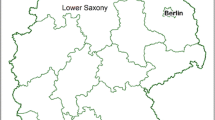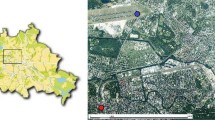Abstract
Previous work on Betula spp. (birch) in the UK and at five sites in Europe has shown that pollen seasons for this taxon have tended to become earlier by about 5–10 days per decade in most regions investigated over the last 30 years. This pattern has been linked to the trend to warmer winters and springs in recent years. However, little work has been done to investigate the changes in the pollen seasons for the early flowering trees. Several of these, such as Alnus spp. and Corylus spp., have allergens, which cross-react with those of Betula spp., and so have a priming effect on allergic people. This paper investigates pollen seasons for Alnus spp. and Corylus spp. for the years 1996–2005 at Worcester, in the West Midlands, United Kingdom. Pollen data for daily average counts were collected using a Burkard volumetric trap sited on the exposed roof of a three-storey building. The climate is western maritime. Meteorological data for daily temperatures (maximum and minimum) and rainfall were obtained from the local monitoring sites. The local area up to approximately 10 km surrounding the site is mostly level terrain with some undulating hills and valleys. The local vegetation is mixed farmland and deciduous woodland. The pollen seasons for the two taxa investigated are typically late December or early January to late March. Various ways of defining the start and end of the pollen seasons were considered for these taxa, but the most useful was the 1% method whereby the season is deemed to have started when 1% of the total catch is achieved and to have ended when 99% is reached. The cumulative catches (in grains/m3) for Alnus spp. varied from 698 (2001) to 3,467 (2004). For Corylus spp., they varied from 65 (2001) to 4,933 (2004). The start dates for Alnus spp. showed 39 days difference in the 10 years (earliest 2000 day 21, latest 1996 day 60). The end dates differed by 26 days and the length of season differed by 15 days. The last 4 years in the set had notably higher cumulative counts than the first 2, but there was no trend towards earlier starts. For Corylus spp. start days also differed by 39 days (earliest 1999 day 5, latest 1996 day 44). The end date differed by 35 days and length of season by 26 days. Cumulative counts and lengths of season showed a distinct pattern of alternative high (long) and low (short) years. There is some evidence of a synchronous pattern for Alnus spp.. These patterns show some significant correlations with temperature and rainfall through the autumn, winter and early spring, and some relationships with growth degree 4s and chill units, but the series is too short to discern trends. The analysis has provided insight to the variation in the seasons for these early flowering trees and will form a basis for future work on building predictive models for these taxa.






Similar content being viewed by others
References
Adams-Groom B, Emberlin J, Corden JM, Millington W, Mullins J (2002) Predicting the start of the Betula pollen season at London, Derby and Cardiff, United Kingdom, using a multiple regression model, based on data from 1987 to 1997. Aerobiologia 18:117–123
Ahas R, Aasa A, Menzel A, Fedotova VG, Scheifinger H (2002) Changes in European spring phenology. Int J Climatol 22:1727–1738
Aron R (1983) Availability of chilling temperatures in California. Agric Meteorol 28:351–363
British Aerobiology Federation (1995) Airborne pollens and spores: a guide to trapping and counting. British Aerobiology Federation, Worcester, UK
D’Amato G, Spieksma FTM (1992) European allergenic pollen types. Aerobiologia 8:447–450
Dreissen MNBM, Van Herpen RMA, Moelands RPM, Spieksma FTM (1989) Prediction of the start of the grass pollen season for the western part of the Netherlands. Grana 28:37–44
Dreissen MNBM, Van Herpen RMA, Smithuis LOMJ (1990) Prediction of the start of the grass pollen season for the southern part of the Netherlands. Grana 29:79–86
Emberlin J (1997) Grass tree and weed pollens. In: Kay AB (ed) Allergy and allergic diseases, vol 2. Blackwell, Oxford
Emberlin J (2000) Aerobiology. In: Busse WW, Holgate ST (eds) Asthma and rhinitis, vol 2. Blackwell, Oxford
Emberlin J, Savage M, Woodman R (1993) Annual variations in Betula pollen seasons in London 1961–1990. Grana 32:359–363
Emberlin J, Mullins J, Cordon J, Millington W, Brooke M, Savage M, Jones S (1997) The trend to earlier birch pollen seasons in the UK: a biotic response to changes in weather conditions? Grana 36:29–33
Emberlin J, Detant M, Gehrig R, Jaeger S, Nolard N, Rantio-letimaki A (2002) Responses in the start of the Betula (Birch) pollen seasons to recent changes in spring temperatures across Europe. Int J Biometeorol 46:159–170
Faust M (1989) Physiology of temperate zone fruit trees. Wiley, New York
Fitter AH, Fitter RSR (2002) Rapid changes in flowering time in British Plants. Science 296:1689–1691
Frei T (1998) The effects of climate change in Switzerland 1969–1996 on airborne pollen quantities from hazel, birch and grass. Grana 37:172–179
Frenguelli G, Bricchi E (1998) The use of pheno-climatic model for forecasting the pollination of some arboreal taxa. Aerobiologia 14:39–44
Frenguelli G, Speiksma FTM, Bricchi E, Romano B, Mincigrucci G, Nikkels AH, Dankaart W, Ferranti F (1991) The influence of air temperature on the starting dates of the pollen season of Alnus and Populus. Grana 30:196–200
Frenguelli G, Bricchi E, Romano B, Mincigrucci G, Ferranti F, Antognozzi E (1992) The role of air temperature in determining dormancy release and flowering of Corylus avelluna. Aerobiologia 8:415–418
Frenguelli G, Ferranti F, Romano B, Bricchi E, Mincigrucci G, Fornaciari M (1993) Temperature influence on differentiation and release of hazel pollen. Allergie Immunol 25:147–149
Galán C, Cariñanos P, Garcia Mozo H, Alcazar P, Dominguez Vilches E (2001) Model for forecasting Olea europaea L. airborne pollen in South-west Andalusia, Spain. Int J Biometeorol 45:59–63
Galán C, García Mozo H, Vázquez L, Ruiz L, Díaz de la Guardia C, Trigo MM (2005) Heat requirement for the onset of the Olea europaea L. pollen season in several sites in Andalusia and the effect of the expected future climate change. Int J Biometeorol 49:184–188
Goldberg C, Buch H, Moseholm L, Weeke EV (1988) Airborne pollen records in Denmark, 1977–1986. Grana 27:209–217
Goudie A (1996) The nature of the environment, Blackwell, Oxford
Hirst JM (1952) An automatic volumetric spore trap. Ann Appl Biol 39(2):257–265
Hulme M, Jenkins GJ (1998) Climate change scenarios for the UK: scientific report. UKCIP Technical Report No. 1., Climate Research Unit, Norwich
Hulme M, Jenkins GJ, Lu X, Turnpenny JR, Mitchell TD, Jones RG, Lowe J, Murphy JM, Hassell D, Boorman P, McDonald R, Hill S (2002) Climate change scenarios for the United Kingdom: the UKCIP02 scientific report., Tyndall Centre for Climate Change Research, School of Environmental Sciences, University of East Anglia, Norwich, UK
IPCC (2001) Climate change 2001: Impacts, adaption and vulnerability. Contribution of Working Group II to the Third Assessment Report of the Intergovernmental Panel on Climate Change. Cambridge University Press
Jato V, Frenguelli G, Aira MJ (2000) Temperature requirements of Alnus pollen in Spain and Italy (1994–1998). Grana 39:240–245
Jato V, Rodríguez-Rajo FJ, Méndez J, Aira MJ (2002) Phenological behaviour of Quercus in Ourense (NW Spain) and its relationship with the atmospheric pollen season. Int J Biometeorol 46:176–184
Kasprzyk I, Uruska A, Szczepanek K, Latalowa M, Gawel J, Harmata K, Myszkowska D, Stach A, Stepalska D (2004) Regional differentiation in the dynamics of the pollen seasons of Alnus, Corylus and Fraxinus in Poland (preliminary results). Aerobiologia 20:141–151
Laaidi K (2001) Predicting days of high allergenic risk during Betula pollination using weather types. Int J Biometeorol 45:124–132
Latalowa M, Mietus M, Uruska A (2002) Seasonal variations in the atmospheric Betula pollen count in Gdansk (southern Baltic coast) in relation to meteorological parameters. Aerobiologia 18:33–43
Matthiesen F, Ipsen H, Løwenstein H (1991) Pollen allergies. In: D’Amato G, Spieksma FTM, Bonini S (eds) Allergenic pollen and pollinosis in Europe. Blackwell,Oxford
Menzel A, Fabian P (1999) Growing season extended in Europe. Nature 397:659
Meteorological Office (2004) 1971–2000 Averages. http://www.meto.gov.uk/climate/uk/averages/index.html
Meteorological Office (2005) Central England Temperatures. http://www.met-office.gov.uk/research/hadleycentre/obsdata/cet.html
Muñoz-Díaz D, Rodrigo FS (2004) Impacts on the North Atlantic Oscillation on the probability of dry and wet winters in Spain. Clim Res 27:33–43
Nilsson S, Persson S (1981) Tree pollen spectra in the Stockholm region (Sweden), 1973–1980. Grana 20:179–182
Pallant J (2001) SPSS Survival Manual, Open University Press
Parmesan C, Yohe G (2003) A globally coherent fingerprint of climate change impacts across natural systems. Nature 42:37–42
Preston CD, Pearman DA, Dines TD (2002) New atlas of the British and Irish Flora, Oxford University Press
Puc M (2003) Characterisation of pollen allergens. Ann Agric Environ Med 10:143–149
Richardson EA, Schuyler DS, Walker DW (1974) A model for estimating the completion of rest of “Redhaven” and “Elberta” peach trees. Hortoscience 9:331–332
Rodríguez-Rajo FJ, Frenguelli G, Jato V (2003) Effect of air temperature on forecasting the start of the Betula pollen season at two contrasting sites in the south of Europe (1995–2001). Int J Biometeorol 47:117–125
Rodríguez-Rajo FJ, Dopazo A, Jato V (2004) Environmental factors affecting the start of the pollen season and concentrations of airborne Alnus pollen in two localities of Galicia (NW Spain). Ann Agric Environ Med 11(1):35–44
Root TL, Price JT, Hall KR, Schneider SH, Rosenweig C, Pounds JA (2003) Fingerprints of global warming on wild animals and plants. Nature 421:57–60
Sanchez-Mesa JA, Smith M, Emberlin J, Allitt U, Caulton E (2003) Characteristics of grass pollen seasons in areas of southern Spain and the United Kingdom. Aerobiologia 19:243–250
Spieksma FTM, Emberlin JC, Hjelmroos M, Jäger S, Leuschner RM (1995) Atmospheric birch (Betula) pollen in Europe: trends and fluctuations in annual quantities and the starting dates of the seasons. Grana 34:51–57
Acknowledgements
The authors wish to thank the British Atmospheric Data Centre (BADC) for providing access to the Met Office Land Surface Observation Stations Data. Also the Met Office who supplied the initial data via the BADC, Crown Copyright 2002. The UKCIP02 Climate Scenario data have been made available by the Department for Environment, Food and Rural Affairs (DEFRA). DEFRA accepts no responsibility for any inaccuracies or omissions in the data nor for any loss or damage directly or indirectly caused to any person or body by reason of, or arising out of any use of, this data.
Author information
Authors and Affiliations
Corresponding author
Rights and permissions
About this article
Cite this article
Emberlin, J., Smith, M., Close, R. et al. Changes in the pollen seasons of the early flowering trees Alnus spp. and Corylus spp. in Worcester, United Kingdom, 1996–2005. Int J Biometeorol 51, 181–191 (2007). https://doi.org/10.1007/s00484-006-0059-2
Received:
Revised:
Accepted:
Published:
Issue Date:
DOI: https://doi.org/10.1007/s00484-006-0059-2




